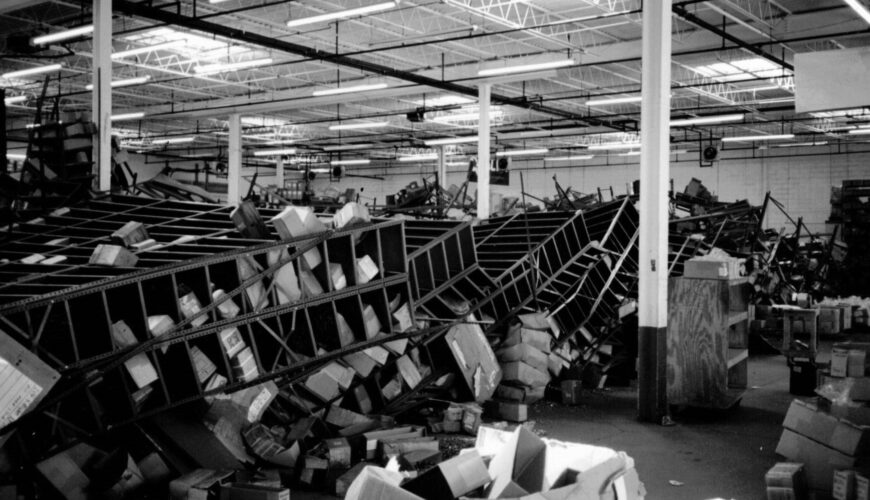Warehouse shelving and rack collapses—like the one pictured—remain one of the most preventable yet devastating hazards in industrial facilities today. These incidents can destroy millions of dollars in inventory and infrastructure, bring operations to a standstill, and pose serious risks to worker safety, including fatal injuries. In nearly every case, such failures are the result of avoidable engineering and compliance oversights.
Understanding the Risks
Most warehouse shelving and rack collapses are rooted in under-engineering, overloading, poor maintenance, improper installation, or a combination of these factors. While they can be triggered by a forklift collision or other mechanical impact, it’s just as common for racks to fail spontaneously—sometimes toppling in sequence like dominoes—without any obvious external cause.
These failures are not only dangerous but are also difficult to assign liability for unless proper engineering documentation exists. This is why modern warehouse design and procurement in 2025 must follow a rigorous, standards-based approach from the outset.
Engineering Documentation Is Non-Negotiable
When sourcing new racking or shelving systems—whether selective pallet racks, push-back racks, drive-in systems, or mezzanine-supported platforms—it is critical to require signed and sealed engineering drawings and load calculations. These must be provided by a licensed professional engineer and include:
- Site-specific seismic and wind load analysis
- Detailed load capacity calculations by bay, beam, and upright
- Connection and anchoring specifications
- System layout drawings with bill of materials
- Conformance to intended use and geographic conditions
In the U.S., compliance with American Institute of Steel Construction (AISC) and Rack Manufacturer’s Institute (RMI) standards is essential. Additionally, the design must meet all federal OSHA regulations, the International Building Code (IBC), and applicable state and local structural and fire codes.
The Danger of Using Unverified or Used Racking Systems
In today’s market, businesses are often tempted to buy used warehouse equipment due to lower costs or shorter lead times. However, unless these components are inspected, tested, and certified by qualified professionals, they pose serious unknowns:
- Are the materials fatigued or damaged?
- Do the parts come from different manufacturers with incompatible tolerances?
- Are welds, fasteners, and anchoring systems structurally sound?
- Has the system ever been exposed to corrosion, overloading, or impacts?
Worse yet, when used components are combined into hybrid systems, it becomes almost impossible to determine who is legally responsible in the event of a failure.
The Right Way to Use Pre-Owned Warehouse Shelving Equipment
If your operation requires the use of used or surplus racking, you must engage in a documented validation process:
- Hire a metallurgical or structural materials engineer to inspect and certify each component’s structural integrity.
- Assemble a verified bill of materials with manufacturer specifications for every beam, upright, brace, and anchor.
- Have a licensed structural engineer design the system and produce signed and sealed structural drawings and calculations based on the certified materials.
- Ensure all local permitting and inspection requirements are met before installation begins.
This approach may add time and cost—but these are small prices to pay for the peace of mind that comes from knowing your storage infrastructure is safe, compliant, and insurable.
How OPSdesign Safeguards Your Investment
At OPSdesign, we are an independent consulting firm—we do not sell equipment, partner with vendors, or profit from any supplier relationships. Our only priority is protecting your interests; we go beyond equipment specs—we deliver engineered assurance.
Our process starts with detailed, code-compliant specifications tailored to your facility. We manage a competitive sealed bid process to ensure only qualified vendors participate (we do not partner with any vendors, we are solely a consulting firm), and we oversee every step to guarantee compliance with AISC, RMI, IBC, OSHA, and local codes.
From structural documentation to lifecycle risk management, we protect your operation from costly errors and liabilities—ensuring your storage systems are safe, scalable, and built to last.
Final Thoughts
In today’s highly regulated and efficiency-driven warehouse environments, cutting corners on warehouse shelving and rack engineering or installation is a false economy. Whether you are building a new DC, upgrading a facility, or expanding your capacity, proper engineering and documentation are not optional—they’re foundational.
The investment in professional design and validation pays for itself by preventing costly downtime, preserving worker safety, and shielding your organization from liability. If you’re unsure whether your current systems meet modern standards, we strongly recommend a professional audit.


